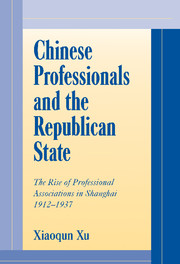 Chinese Professionals and the Republican State
Chinese Professionals and the Republican State Book contents
- Frontmatter
- Contents
- List of Tables
- Acknowledgments
- Abbreviations of Frequently Cited Sources
- Introduction
- Part I Professions and Professionals
- Part II Social Institutions, State Actions, and Professionalization
- 3 The Republican State and Urban Associations
- 4 The Republican State and the Legal Profession
- 5 The Republican State and the Medical Profession
- Conclusion to Part II
- Part III Professionalism, Nationalism, and Politics
- Conclusion
- Glossary
- Bibliography
- Index
3 - The Republican State and Urban Associations
Published online by Cambridge University Press: 07 September 2009
- Frontmatter
- Contents
- List of Tables
- Acknowledgments
- Abbreviations of Frequently Cited Sources
- Introduction
- Part I Professions and Professionals
- Part II Social Institutions, State Actions, and Professionalization
- 3 The Republican State and Urban Associations
- 4 The Republican State and the Legal Profession
- 5 The Republican State and the Medical Profession
- Conclusion to Part II
- Part III Professionalism, Nationalism, and Politics
- Conclusion
- Glossary
- Bibliography
- Index
Summary
THE RELATIONSHIP between voluntary associations and the Chinese state from the late Qing through the Republican era can be traced along a trajectory showing that the state was assuming increasingly modern characters – the trajectory of modern state building. At the same time, the trajectory projects a Chinese urban society growing more and more diverse and heterogeneous, engaging the state in a variety of new ways and for newly emerging societal interests. This chapter will sketch briefly various urban associations in Shanghai during the Qing dynasty and then examine in more detail the urban associations that proliferated, and the state policies toward them, during the Beiyang period and the Nanjing decade. The chapter thus provides a necessary background to the analysis offered in Chapters 4 and 5 of the role of the Republican state in promoting and regulating Chinese professions and professional associations.
URBAN ASSOCIATIONS IN LATE QING SHANGHAI
Various urban associations had long existed in Shanghai just as in the rest of the country. While Shanghai was gradually becoming an important commercial center in the eighteenth and nineteenth centuries, and especially after Shanghai's opening as a treaty port in 1843, migrants from other parts of the country made up the majority of the Shanghai population. Following a familiar pattern seen elsewhere, Shanghai residents organized themselves in native-place associations, trade guilds, labor gangs, secret societies, and gentry-merchant organizations.
- Type
- Chapter
- Information
- Chinese Professionals and the Republican StateThe Rise of Professional Associations in Shanghai, 1912–1937, pp. 83 - 106Publisher: Cambridge University PressPrint publication year: 2000


